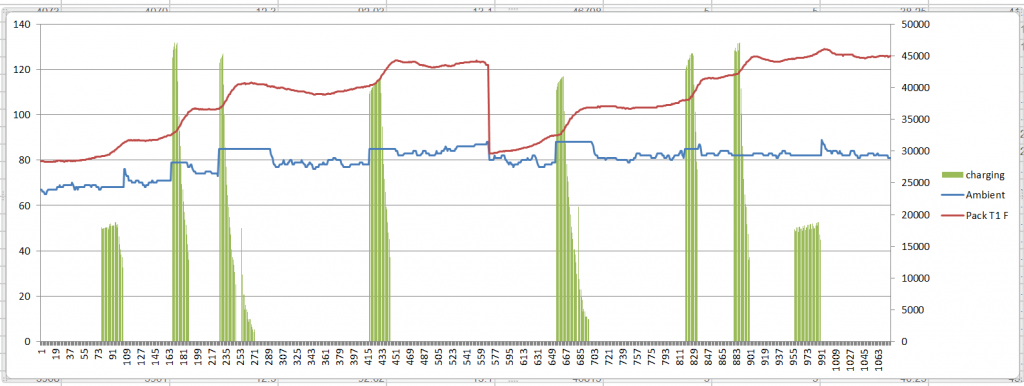OK, let's squash some bogus misinformation here real, real fast before we get too far into page 2. Sorry, I was away all day on a *really* long-running work project today, and haven't been on a forum in quite a while so I hope I can keep on top of this.
Yes, the motor, controller (/inverter/charger, all combined as one "power management unit" as I'd call it)
and battery are ALL thermally related. You can't connect two components with a big piece of conductive metal and say "they don't affect one another". You can't group them all under one huge insulating (yes, insulating, not conducting - the hood is NOT a good conductor of heat as I've observed by a cold hood and hot parts) cover and then say "they don't conduct". The motor/controller block heat
DOES heat the battery pack if not dissipated by the cooling fan. This is observable by just walking out to any 2013 Leaf (S, in my case) at the end of a charging cycle and observing the temperatures. Very easy to test, very easy to see how they relate. The metal frame and shell of the car will either conduct heat away from the pack towards the cooler components, or will conduct heat from the hotter components into the battery pack. That's simple science. Let's move past the elementary stuff and think about how to solve the problem, not act like it doesn't exist.
Unfortunately, since most of this thread so far has been dominated by EVDRIVER sprawling bogus info about heat transfer, that's really all that's been touched on so far. Another good point is that the 6,000-plus watt charger does, in fact, produce a significant amount of waste heat that gets absorbed (via the activated water-cooling system) into the motor/controller block, which acts as a heat energy capacitor - the radiator does not do any cooling whatsoever without air moving through it - it's just another capacitor. Since there's an enormous amount of aluminum in the motor block components,
with aluminum being the highest heat-capacity metal commonly available, most of that waste heat gets stored, not dissipated, at the time of charging. That stored waste heat gets conducted and dissipated through the car body over a much longer period of time than the charging cycle lasts, probably with the bulk of the waste heat getting flushed out the next time the car gets driven (which removes the heat
extremely fast).
The issue here is that the cooling system was designed with car-in-motion in mind, not parked-car as in the case of charging - where most of the electronics heat is produced. This is why I see it as a "old school of thought" induced design flaw - Nissan's so used to making cars that have to cool while in motion, that they forgot things like creating an airflow feedback loop as found in the gap between the radiator and the fan shroud (check under your hood while the fans run - you'll find hot air sucking back into the fan!). Non-issue for ICE cars that don't usually produce much heat while stationary... but a big one for EVs where the opposite is true.
Oh - and it's worth noting: the water cooling system *is* active for the entire period of charging - you can tell by a slight hum from the controller block, and by squeezing a cooling line to feel the coolant flow (it's a brushless pump with a reservoir, no damage can occur by doing so). That's how the charger manages to dissipate the heat that would require a jet-engine of a fan to cool by air cooling. Unfortunately, though, there's no air cooling - there's just heat distribution; storing that waste heat in other system components instead.
ed.: ah, and yes, I've got the 2013 S, and was pretty disappointed to find that I didn't have the heat pump -
after signing the lease. Can't comprehend why Nissan would develop two completely different heating systems for something as simple as saving a reversing valve on the S trim. But no - while I can probably use a heat pipe coupled to the exposed metal on the low-pressure hose and put the other end into the water-cooling loop :ugeek: , I can't reverse the A/C to blow cold air. I *SO* wish I could, though! :lol:


